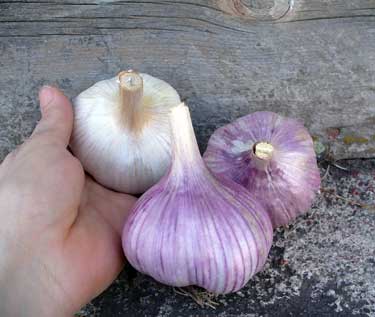Garlic May Help Prevent Skin Aging: A Clove A Day Could Keep Wrinkles at Bay
By Susan Fluegel, PHD
Skin aging is caused by multiple external and internal factors including UV radiation, smoke, stress and genetics. Most visible skin aging is caused by photoaging, which results from the combination of repeated UV damage and intrinsic aging (Fisher et al. 2002).
Wrinkles are a visible sign of photoaging and can result from collagen fibrils and gelatin fibers breaking down or degrading (Lee et al. 2006). Garlic compounds act as antioxidants, inhibit NF-κB activation, and protect against UV-induced immunity suppression (Pfau et al. 2011, Kim et al. 2013). Through these actions, garlic may inhibit or slow down skin aging and the resulting wrinkles helping you look younger longer.
 Picture: A tasty German Red garlic bulb rests in a hand by two sweet Chesnok Red garlic bulbs. Eating this delicious bulb could help stave off wrinkles.
Picture: A tasty German Red garlic bulb rests in a hand by two sweet Chesnok Red garlic bulbs. Eating this delicious bulb could help stave off wrinkles.
Kim et al. (2013) looked at whether or not three isolated garlic compounds; caffeic acid (CA), S-allyl cysteine (SAC), and uracil; could influence UVB-induced wrinkle formation and/or the expression of matrix-metalloproteinase (MMP) and NF-κB signaling. For more on why these parameters were chosen see mechanism below.
Results: all three garlic compounds, CA, SAC and uracil, significantly inhibited degradation of type І procollagen, inhibited MMP expression, hindered histological collagen fiber disorder and alleviated oxidative stress in vivo. In addition, CA and SAC decreased oxidative stress and inflammation by modulating NF-κB and AP-1. Uracil reduced oxidative stress by suppressing cyclooxygenase-2 (COX-2), inhibiting inducible nitric oxide synthase (iNOS) expressions levels and downregulating transcriptional factors.
Take home message: The three active garlic compounds CA, SAC, and uracil inhibited wrinkle formation caused by UV light. CA, SAC and uracil reduced skin aging by increasing type I procollagen formation and reducing oxidative stress.
Mechanism by which Garlic May Protect Against Wrinkles:
It is well accepted that UVA and UVB exposure are related to or a risk factor of accelerated skin aging and development of skin cancers (Quan et al. 2009). UV irradiation damages type 1 collagen synthesis. It also stimulates release of pro-inflammatory mediators. These pro-inflammatory chemicals prompt increased expression of various matrix metalloproteinase (MMP) compounds.
MMPs degrade collagen and other types of extracellular matrix proteins that make up the dermal connective tissue in your skin. In other words, UV light indirectly activates MMPs which chew up the connective proteins that keep your skin nice and tight. Inflammation can also activate MMPs which may be one reason that stress (which increases inflammation) seems to accelerate aging.
UVB caused DNA damage activates transcription factor pathways such as nuclear factor-κB (NF-κB) and activator protein-1 (AP-1). These pathways regulate expression of many genes including COX-2, MMPs, TNFα, and IL-1. NF-κB regulation is also influenced by signaling cascades activating AP-1 (Studzinski et al. 1996). Treatments that inhibit pathways leading to pro-inflammatory compounds such as NF-κB and AP-1 may be useful in combating skin aging.
Note: In many things in life, moderation is key. Even though some of these factors, such as NF-κB, are known as 'pro-inflammatory compounds' they may have both pro- and anti-inflammation roles in the body (Lawrence 2009).
Reference:
- Bode AM, Dong Z. Mitogen-activated protein kinase activation in UV-induced signal transduction. Sci STKE, 2003:RE2. PubMed.
- Fisher GJ, Kang S, Varani J, Bata-Csorgo Z, Wan Y, Datta S, Voorhees JJ. Mechanisms of photoaging and chronological skin aging. Arch Dermatol. 2002;138:1462-1470. PubMed. doi: 10.1001/archderm.138.11.1462
- Kim SR, Jung YR, An HJ, Kim DH, Jang EJ, Choi YJ, Moon KM, Park MH, Park CH, Chung KW, Bae HR, Choi YW, Kim ND, Chung HY. Anti-wrinkle and anti-inflammatory effects of active garlic components and the inhibition of MMPs via NF-κB signaling. PLoS One. 2013; 16;8:e73877. Pubmed. doi: 10.1371/journal.pone.0073877 (full text)
- Lawrence T. The Nuclear Factor NF-κB Pathway in Inflammation. Cold Spring Harb Perspect Biol. 2009;1:a001651. doi: 10.1101/cshperspect.a001651
- Lee SM, Lee CT, Kim YW, Han SK, Shim YS, Yoo CG. Hypoxia confers protection against apoptosis via PI3K/Akt and ERK pathways in lung cancer cells. Cancer Lett. 2006;242:231-238. PubMed. doi: 10.1016/j.canlet.2005.11.001
- Pfau JC, Li S, Holland S, Sentissi JJ. Alteration of fibroblast phenotype by asbestos-induced autoantibodies. J Immunotoxicol. 2011;8:159-169. PubMed. doi: 10.3109/1547691X.2011.562257
- Studzinski GP, Rathod B, Rao J, Kheir A, Wajchman HJ, Zhang F, Finan JB, Nowell PC. Transition to tetraploidy in 1,25-dihydroxyvitamin D3-resistant HL60 cells is preceded by reduced growth factor dependence and constitutive up-regulation of Sp1 and AP-1 transcription factors. Cancer Res. 1996;56:5513-5521. PubMed. Full text.
- Quan T, Qin Z, Xia W, Shao Y, Voorhees JJ, Fisher GJ. Matrix-degrading metalloproteinases in photoaging. J Investig Dermatol Symp Proc. 2009;14: 20-24. PubMed. doi: 10.1038/jidsymp.2009.8 (full text)
